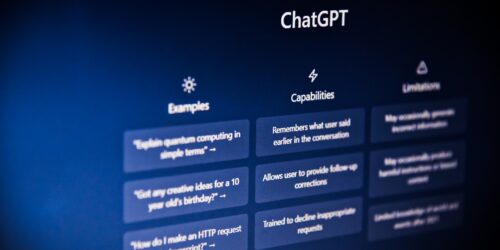Describe and Document AI Use
Disclosure of AI use involves sharing what tools were used, how they were used, and why they were used. They may also include human effort or a description of how or why they were not used. AI disclosure in scholarly activity promotes transparency and the thoughtful, responsible use of AI.
Conestoga Guidelines for Student AI Use
You may wish to provide students with the optional use of generative AI when completing learning tasks and/or assignments. For assignments, Conestoga’s Evolving AI Guidelines provide the following recommendations to faculty:
“Written instructions must clearly state whether use of AI is permitted [for assignment]. When AI is permitted, students should also cite and reference its use appropriately. Best practices indicate they should also include an acknowledgement. For example, an assignment completed in collaboration with Copilot should include a statement like “This assignment was completed with the assistance of MS Copilot (February 20, 2024 version).”
Create and share a Statement of AI Use that explains your expectations to students up front. Note that how and to what extent you ask students to use and disclose their AI use will depend on many factors.
Types of Disclosure for Different Purposes
The type of AI disclosure will depend on the goal and the learning task’s process. AI use should never be used to replace or shortcut the demonstration of knowledge and/or skills.
Below are 5 ways to disclose AI use.
1. APA-style citations and references
AI can be an information or research resource (Weaver, 2024). Citing an AI chatbot involves acknowledging the source of information obtained from the chatbot in your work. It gives credit to the creators of the AI and for allowing others to trace the origin of the information.
When to use it: When quoting, paraphrasing, or summarizing AI as an information source. In essence, the creator of the AI is the “author” of the source from which quotes, paraphrases, or summaries are used.
Share your expectations: Explain that AI chatbots create “new” outputs every time, derived through a predictive algorithm that draws from the LLMs training data. If you use the words or ideas from the AI output, you must cite and reference it for academic integrity. See the Hub post Citing Generative AI for more information. Help students learn about AI citations by showing them the Generative AI Toolkit for Students – How to Cite AI.
Sample instructions for students
Where an assignment requires the use of generative AI tools to be cited, you must reference all the content from Generative AI tools that you include. Failure to reference externally sourced, non-original work can result in academic misconduct. References should provide clear and accurate information for each source and identify where they have been used in your work.
Based on APA 7 Style guidance.
In-text
Author of generative AI model, Year of version used
Example: (Copilot, 2024) or Copilot (2022)
Reference list
Author of AI model used. (Year of AI model used). Name of AI model used (Version of AI model used) [Type or description of AI model used]. Web address of AI model used
Example:
Copilot. (2024). Copilot [Large language model]. https://chat.openai.com/
2. Describe AI collaboration
AI can be an educational resource for conceptualization, information collection, visualization, and writing review and editing (Weaver, 2024). Describing AI collaboration involves summarizing the process by which AI was used to design, develop, or refine the learning task output. This describes how, how much, and when AI was used.
When to expect it: When students use AI for brainstorming, researching, outline, categorizing, analyzing, evaluating or creating a product. In essence, AI is an aid or collaborator in the work.
Share your expectations: Explain the permitted ways that AI may be used, then give specific examples of appropriate summaries that give sufficient levels of detail. Here are some examples.
- Initial draft generation: “I used generative AI to generate the initial text draft. I then reviewed, edited, and refined this draft to produce the final output.”
- Idea generation: “I used generative AI to generate various ideas and concepts. I selected the most promising ones and developed them further on my own to create the final text.”
- Content expansion: “I provided the AI with a basic outline or a set of key points. The AI then expanded on these points to create a more detailed and comprehensive text, which I revised and finalized.”
- Iterative refinement: “I used the AI in an iterative process. I would input a draft, the AI would revise and enhance it, and then I would review and adjust the AI’s output. This cycle was repeated until the final text was produced.”
- Language enhancement: “I wrote the initial text, and then used the AI to enhance the language, improve the style, and correct grammatical errors. The final output was a polished and refined version of my original text.”
You might create a list of appropriate options for students to select and adapt. You might also wish to to ask students to include this description at the beginning or end of their submission, or in a message along with their submission in eConestoga.
Sample instructions for students
If you use generative AI to help you generate ideas or plan your process, you should still acknowledge how you used the tool, even if you don’t include any AI-generated content in the assignment. Please iinclude the following information when referencing generative AI content:
- generative AI system (e.g. Copilot, please do not use other AI chatbots)
- company (e.g. Microsoft)
- the web address of the system
- a brief description of how you used the tool (e.g. edited/corrected/translated/planned/brainstormed)
- date.
Example: This work was corrected using Copilot (Microsoft, https://copilot.microsoft.com/) on 30 July 2024. I asked Copilot to correct any grammar errors and provide academic style suggestions.
Note that you may use Copilot to summarize your conversation or collaboration. Please use this AI prompt:
Please carefully review the conversation today, then give me a concise narrative summary of the exchange. Summarize exactly what I asked you to do that you did, and also what I did to refine, narrow, or expand your outputs. Focus on the key steps in the conversation and/or development process. Highlight any specific actions or decisions I made that significantly influenced the development process. Use a paragraph format. Be accurate, and do not overstate, elaborate, or embellish what you or I did beyond what is evident in the exchange. Put the paragraph in the first person, and referring to you, the AI tool, in the third person. Before providing the summary, double-check that it is accurate and did not omit, change, hallucinate, or embellish anything.
3. Provide AI Use Documentation
Providing AI documentation involves including artifacts of the outputs or conversations that AI provided for students.
Expect it: Students who use AI to create specific outputs are asked to “do more” with it (critique, evaluate, revise, verify, etc.). Or, students are asked to use AI as a conversation or critical thinking partner. In essence, there is a need to verify that the learning task output differs from what AI-generated or that a “conversation” was had between AI and the student.
Share your expectations: Students can document their use of generative AI in several ways to demonstrate their active role in the development process. Here are some examples.
- Screenshots: Capture images of the genAI interface during use, showing the input given and the AI’s output.
- Prompt and Output Logs: Record and share the interactions with the genAI, including the prompts or questions, the AI’s responses, and adjustments made based on those responses.
- Annotations: Students may be asked to highlight or annotate their final submission, indicating which parts were generated or influenced by the AI and providing a brief explanation.
- Process documentation: Create a step-by-step account of the assignment process, detailing how the AI was used at each stage. See below for an example.
Note that MS Copilot only allows individual prompts and responses to be copied. You may need to give instructions and/or demonstrate how students should keep track of their AI use. For instance, students may not know how to take screenshots.
Sample learning tasks that ask for AI use documentation
See this sample Padlet, Documenting AI Use for Story 2, provided by Elan Paulson to her LIBS1265 students as part of a writing assignment in which AI outlines a life story.
See this sample assignment information, Embedding AI in Activities and Assignments, provided by Anita Nickerson.
Sample instructions for students
While using Copilot, keep a copy of the prompts you provide to it, the outputs it provides to you, and screenshots of your conversation. You will be asked to share at least one output and screenshot for this assignment to show how you used Copilot with integrity. Below are some instructions on how to take a screenshot and how to save Copilot outputs.
Steps to document:
- Open a Word document. Type the title of the assignment and the words “Copilot Appendix” at the top of the page. E.g., Story 1 Copilot Appendix.
- Open a second browser window. Log in to the Conestoga-licensed version of Copilot. You MUST use this tool to protect your personal information and intellectual property. Other AI tool use is prohibited for this assignment.
- Use Copilot as specified in the assignment instructions.
- Copy the response the Copilot gives you. Paste it in the Word document. Remember that the response should not be copied directly into your assignment; it should provide you with ideas, information, or feedback you read and apply to your assignment.
- Take a screenshot of an exchange (the conversation) between you and Copilot. Paste it in the Word document. How to take a screenshot on your PC, Phone, or Tablet (Webwise)
- Add the date of the Copilot conversation. Label each entry with the date if you used Copilot more than once.
4. Complete an AI process form or reflection
Completing an AI disclosure or process form helps students explain how much AI helped their work. It covers idea creation, research, planning, writing, and editing. It clearly distinguishes how AI may be used (or not if students opt out of AI use). This practice makes the role of AI transparent, helps students understand their learning, and makes them think about the correct use of AI for the task(s). It may be a step that is added to requiring students to cite and reference AI outputs.
When to use it: Use this strategy when AI is being integrated in multiple ways throughout an assignment or to distinguish levels of permitted and prohibited uses of AI.
Share your expectations: If you choose to use a process form along with an assignment, you may wish to review it with students well before the due date. Also, ensure that students are clear about your expectations for the permitted (and prohibited) use of AI and how they should keep track of their AI use. See The Optional Use of Generative Artificial Intelligence (GenAI) in Assessments for details.
Sample forms for students
You may wish to use a collaborative document to help students capture how they used generative AI. This can help students be clearer on how to proceed with disclosing their AI use.
- See this AI Process Form for Students (editable) (MS Word), which you may wish to download and adapt for your assignments. This sample is adapted from “AI Disclosure Form” by François Jourde (2024) under the license CC-BY-NC-SA.
- See this Academic Honesty and Integrity with AI Canva template, created by Christina DiMicelli (2024). (Note this document is not fully accessible.)
5. AI Acknowledgement Statement
An AI Acknowledgement statement precedes a learning task output or assignment, and it identifies the strengths, limitations, and risks of AI in general and how AI was used specifically.
When to use it: Before a large project, presentation, or work that requires acknowledging important information for an audience. Or to anticipate questions or concerns the audience may have about general or specific potential harms of AI.
Provide a model or an example for students to follow. Talk about what it discloses generally (harms of AI) and specifically (how AI was used, especially to minimize harms).
Sample for students
“This presentation was prepared using several AI chatbots including ChatGPT, Google Gemini, and Claude.ai. I acknowledge that AI chatbots do not respect the individual rights of authors and artists, and ignore concerns over copyright and intellectual property in the training of the system; additionally, I acknowledge that the system was trained in part through the exploitation of precarious workers in the global south. In this work I specifically used AI tool to review content, provide images, and create some of the content I demonstrate.” (Lanclos & Phipps, 2023)
Lanclos, D., & Phipps, L. (2023). Digital Is People. Retrieved from https://digitalispeople.org/an-offering/
This example was generously provided by Lisa Long in her presentation, Cyborgs and Centaurs: Ethical AI Integration in Writing Instruction [Webinar]. (2025, January 15). University of Regina.
How might AI disclosure strategies be encouraged?
Since AI disclosure is a new and additional task for students, they will likely need support and encouragement to be successful with AI disclosure activities. See the accordion below for ideas supporting AI disclosure in learning tasks and assignments.
Ideas to encourage AI disclosure
- Clearly outline what is expected regarding AI use. Ensure guidelines are applied consistently in all tasks.
- Explain the importance of entering specific information for Copilot. Introduce the topic and shift students’ mindset about AI use past the idea that “AI is cheating.”
- Demonstrate a task and model AI disclosure strategies. Show examples and allow students to practice before the assignment submission. Provide a step-by-step process for using AI within the guidelines. Provide clear examples of what not to do with AI.
- Have a discussion and provide feedback on AI use. Conduct regular check-ins to monitor and guide students’ AI use.
- Start with low stakes tasks to encourage practice. Explain that students may be asked to follow these practices in their future workplaces.
- Integrate AI use and disclosur into assignments. Provide “checklist points” to follow.
When might AI documentation not be necessary or desirable?
It depends. Disclosure may not be necessary for tasks that students already know how to do and/or are automated to save time. Or, you may only be interested in the “product” of their learning, not the “process.” For example, you may decide that students who use AI to brainstorm or acquire resources for a class activity or assessment may not need a description/documentation of their use of AI.
The norms of the academic discipline of your professional area may also guide your decisions. When in doubt, refer to Conestoga’s Evolving AI Guidelines and contact your supervisor.
Final thoughts
If you wish to provide students with optional use of generative AI for activities and assignments, discussing the risks of using 3rd party genAI tools in class is strongly recommended. Also, you can help students understand your expectations by demonstrating what you ask of students. Finally, please note that students cannot be required to use a specific AI tool for class activities and assignments. Alternative opportunities with equitable support must be provided for any assigned tasks.
References and AI Disclosure
Queensland U (2024). Generative AI tools for assignments. Library Guides – Referencing.
Weaver, D. (2024). The artificial intelligence disclosure (AID) framework: An introduction. University of Waterloo.
Note: In this post, examples were developed in collaboration with AI: detailed prompts were provided, and outputs were human-revised and finalized.



